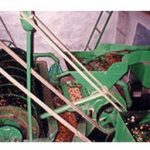As I promised in my last post, here I compare the Ethiopian Yirgacheffe coffee to the Guatemalan Heuheutenango that I currently favor. The Yirgacheffe has a distinctive flavor, caused partly by the fact that it is wet processed. Here is a summary of dry processing versus wet processing.
Dry Process
Dry process, also known as unwashed or natural coffee, is the oldest method of processing coffee. The entire cherry after harvest is first cleaned and then placed in the sun to dry on tables or in thin layers on patios.

Wet Process
In the Wet Process, the fruit covering the seeds/beans is removed before they are dried. Coffee processed by the wet method is called wet processed or washed coffee. The wet method requires the use of specific equipment and substantial quantities of water.
The coffee cherries are sorted by immersion in water. Bad or unripe fruit will float and the good ripe fruit will sink. The skin of the cherry and some of the pulp is removed by pressing the fruit by machine in water through a screen. The bean will still have a significant amount of the pulp clinging to it that needs to be removed. This is done either by the classic ferment-and-wash method or a newer procedure variously called machine-assisted wet processing, aquapulping or mechanical demucilaging.
And now for something completely different. I’ve completed my initial taste-testing of the Ethiopian Yirgacheffe coffee beans to the Guatemalan Heuheutenango. The Yirgacheffe surprised and delighted me. While I found the Guatemalan Heuheutenango, Hawaiian Kona and Costa Rican Tarrazu beans to all be very similar, smooth and subdued and earthy, I found the Yirgacheffe to have a distinctive flavor, bright and floral with some fruitiness. It will definitely become a part of my repertoire.
BTW, my taste-testing method was the same as described yesterday. I ground enough coffee beans for four 6 ounce cups of coffee for each type of coffee (approximately two tablespoons per 6 ounce cup), grinding them for 12 seconds in my blade grinder, resulting in a fairly fine though not powdery grind. I added five 6 ounce cups of water to my Mr. Coffee-type drip maker, ending up with four 6 ounce cups of coffee. I drink 10 ounce cups of coffee, so I ended up with two and a half of each type. As I am now familiar with the taste of my Heuheutenango, I started with the Yirgacheffe. I drank one and a half 10 ounce cups to familiarize myself with the flavor, saving the last 10 ounce cup for side-by-side comparison. Then I brewed the Heuheutenango and drank one and a half 10 ounce cups side-by-side the Yirgacheffe.
Next up I’ll be testing the Ethiopian Yirgacheffe against another African coffee, a Tanzanian Mbeya Reserve coffee which a friend of mine gave me. I’ll be testing them this week-end and reporting on the results at that time.





To the blogger: Did you know that Starbucks took down all Ethiopian coffee brands used to promote as part of 2007 agreement with Ethiopian Gov. I visited several store that told me the same story.